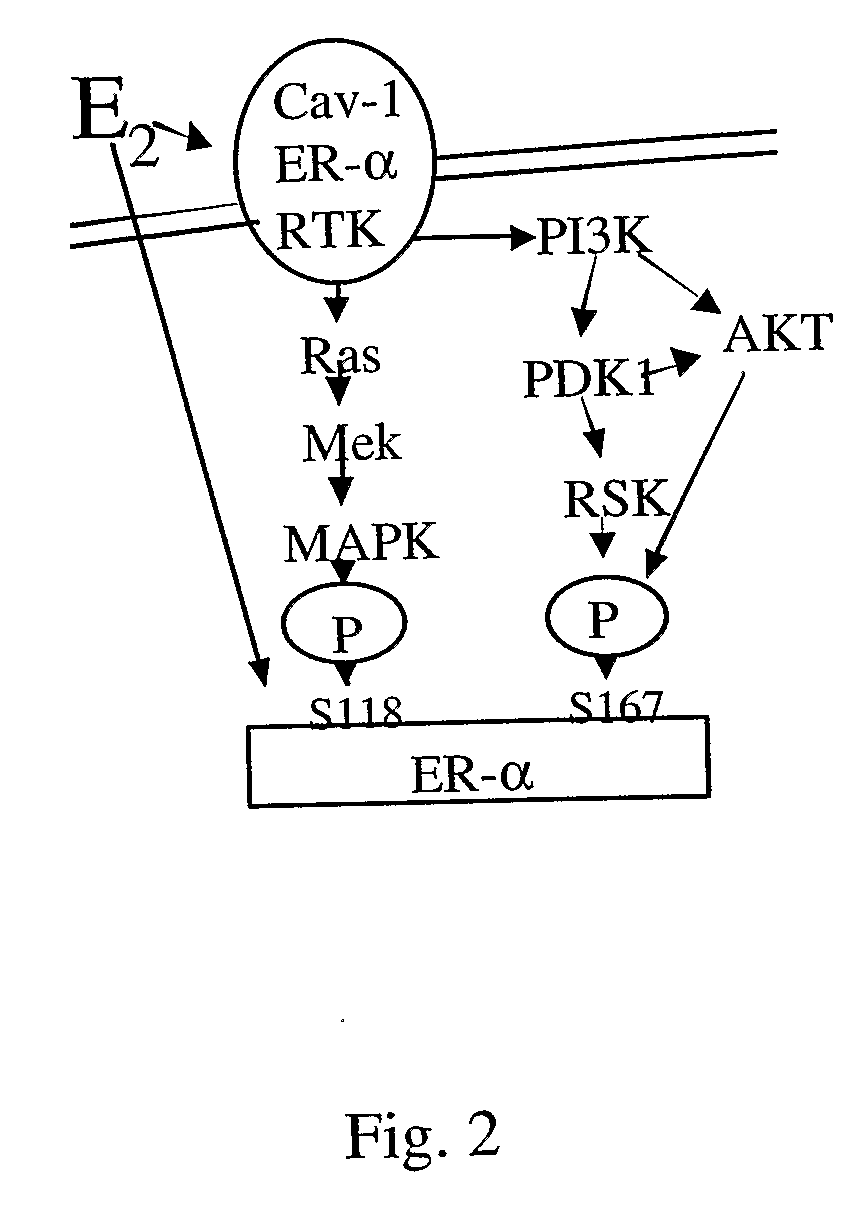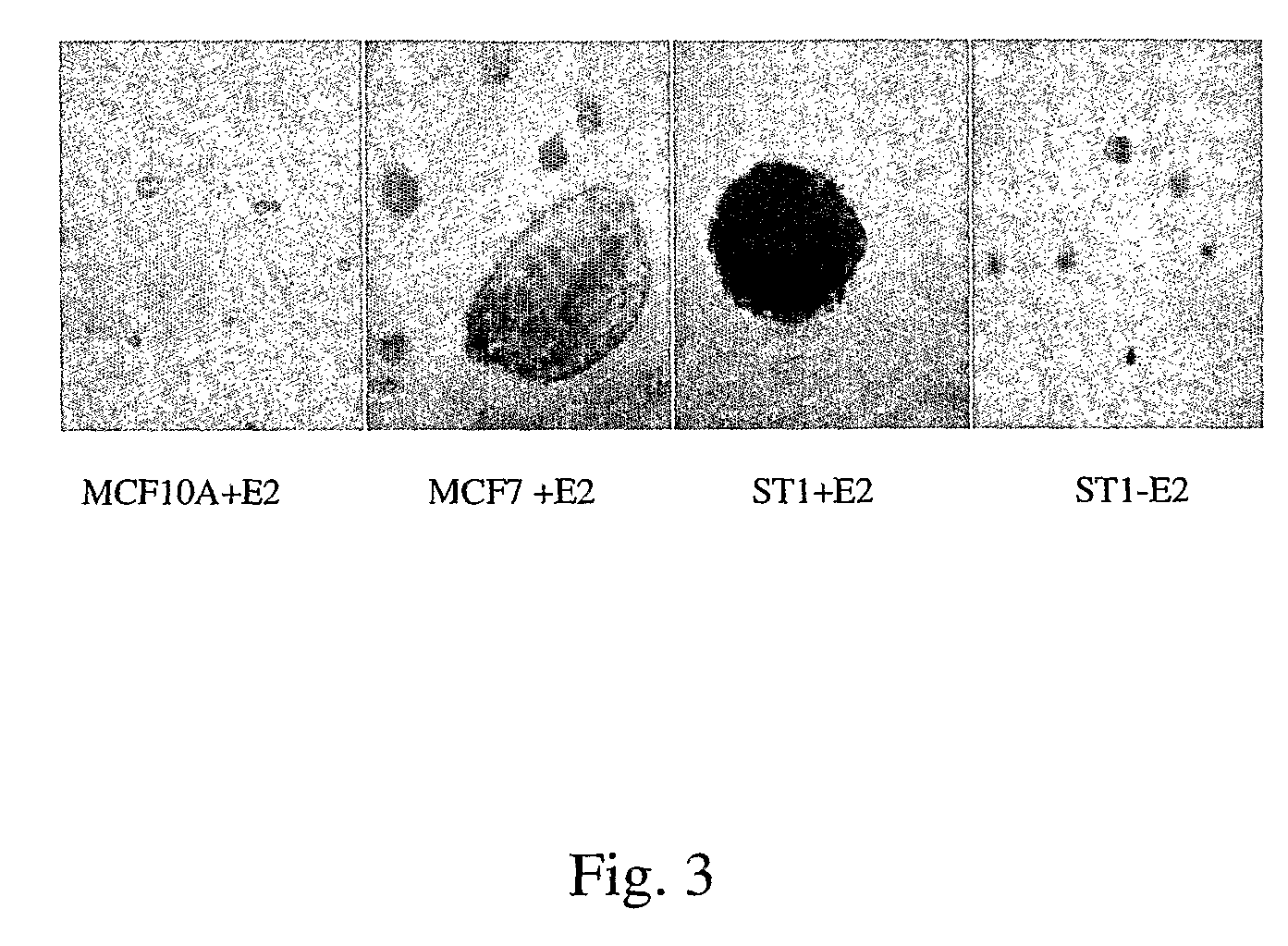Estrogen Receptors and Methods of Use
a technology of estrogen receptors and receptors, applied in the field of estrogen receptors, can solve the problems of increasing the risk of endometrial cancer, and achieve the effect of inhibiting the activity of er-36 cells
- Summary
- Abstract
- Description
- Claims
- Application Information
AI Technical Summary
Benefits of technology
Problems solved by technology
Method used
Image
Examples
example 1
Caveolin-1 Haploinsufficiency Produces Activation of ER-α Expression and Estrogen Stimulated Transformation of Normal Breast Epithelial Cells
[0125] A gene-trapped library of cell clones from normal human mammary epithelial MCF10A cells was prepared through use of a poly-A trap retrovirus vector (RET) obtained from Dr. Philip Leder's laboratory at Harvard Medical School (Ishida et. al., Nucl. Acid Res., 27:580 (1999)). Briefly, this vector used an improved poly-A trap strategy for the efficient identification of functional genes regardless of their expression status in target cells. A combination of a strong splice acceptor and an effective polyadenylation signal assures the complete disruption of the function of “trapped” genes. Inclusion of a promoterless GFP cDNA in the RET vector allows the expression pattern of the trapped gene to be easily monitored in living cells. A retrovirus containing the RET vector was used to infect MCF10A cells. The cells were then screened for G418-re...
example 2
Identification, Cloning, Expression and Characterization of an Isoform of Estrogen Receptor Alpha (ER-α36)
[0132] During the course of the work described above, three protein bands (66-kDa, 46-kDa and 36-kDa) were consistently observed in western blot analysis using the Rat anti-ER-α antibody (clone H222) from Research Diagnostic, INC. The H222 antibody recognizes the ligand-binding domain of ER-α. To exclude the possibility that 46-kDa and 36-kDa protein bands were the degradation products of ER-α66, as suggested by a previous report (Abbondanza et. al., Steroids, 58:4 (1993)), cells were lysed in culture plates using a buffer containing 8 M urea and tested by western blot analysis. Three distinct bands were readily observed in Cav-1 haploinsufficient cells, ST1 and ST3, and MCF7 breast cancer cells (FIG. 7). These results indicated the existence of ER-α isoforms that share a similar epitope that is recognized by the antibody H222.
[0133] Through a literature search, it was found t...
example 3
ER-α36 Mediates Membrane-Initiated Estrogen Signaling and is Expressed in ER-Negative Breast Cancer
Methods
[0139] Cell culture, establishment of stable cell lines and membrane-labeling with E2-BSA-FITC. MCF10A cells were obtained from Karmanos Cancer Institute at Detroit, Mich., and human embryonic kidney 293 cells, and all breast cancer cells were obtained from ATCC. All cells were maintained at 37° C. in a 5% CO2 atmosphere in appropriate tissue culture medium. To establish stable cells that express recombinant ER-α36, HEK293 cells were plated at a density of 1×105 cells per 60-mm dish and transfected 24 hours later with ER-α36 expression vector driven by the cytomagalovirus (CMV) promoter using the FuGene6 transfection reagent (Roche Molecular Biochemicals). The ER-α36 expression vector was constructed by cloning a 1,1-kb EcoRI-BamHI cDNA fragment of ER-α36 from pBS-ER-α36 into the EcoRI and BamHI sites of mammalian expression vector pCB6+. Empty vector was also transfected int...
PUM
| Property | Measurement | Unit |
|---|---|---|
| Fraction | aaaaa | aaaaa |
| Fraction | aaaaa | aaaaa |
| Composition | aaaaa | aaaaa |
Abstract
Description
Claims
Application Information
 Login to View More
Login to View More - R&D
- Intellectual Property
- Life Sciences
- Materials
- Tech Scout
- Unparalleled Data Quality
- Higher Quality Content
- 60% Fewer Hallucinations
Browse by: Latest US Patents, China's latest patents, Technical Efficacy Thesaurus, Application Domain, Technology Topic, Popular Technical Reports.
© 2025 PatSnap. All rights reserved.Legal|Privacy policy|Modern Slavery Act Transparency Statement|Sitemap|About US| Contact US: help@patsnap.com



